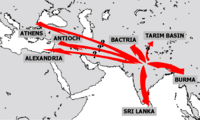Edicts of Ashoka

This article does not have any sources. (May 2024) |
The Edicts of Ashoka are a collection of 33 inscriptions on the Pillars of Ashoka, as well as on large stones and cave walls, made by the Emperor Ashoka of the Mauryan dynasty during his reign from 272 to 231 BCE. The edicts describe in detail the first wide expansion of Buddhism. According to the edicts, the extent of Buddhist proselytism during this period reached as far as the Mediterranean, and many Buddhist monuments were created.

Ashoka did not completely forbid the killing of animals; he wanted to control the number of animals that had to be killed for human consumption or sacrificing, protected some of them, and in general criticized violent acts against animals, such as castration. He wrote these edicts on rock and pillar.
Edicts are royal orders or proclamations.These edicts were set up in different part of Ashoka's empire and spread the message of Ashoka's Dhamma.There are about 14 rock edicts and 7 pillar edicts currently found.
Edicts were written in local language. Most of the Ashoka's edicts are written in Brahmi Script and were translated by James Prinsep, a British official in 1837. After this major breakthrough, historians and scholars were able to obtain information about Ashoka and his reign.
References
[change | change source]- "The Edicts of King Asoka: An English Rendering" by Ven. S. Dhammika (The Wheel Publication No. 386/387) ISBN 955-24-0104-6
- “Zen living” by Robert Linssen ISBN 0-8021-3136-0
Other websites
[change | change source]- The Edicts of King Ashoka (full text, electronic edition offered for free distribution)
- The Edicts of King Ashoka Archived 2005-07-27 at the Wayback Machine in Access to Insight
- Edicts in original Gandhari
- King Asoka and Buddhism. Historical and Literary studies Archived 2012-09-23 at the Wayback Machine
- Inscriptions of India -- Complete listing of historical inscriptions from Indian temples and monuments